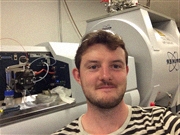Tutor HuntResources Chemistry Resources
Cholesteric Liquid Crystals - Fats, Fats And Yet More Fats
A brief article aimed at a non-technical audience
Date : 05/04/2013
Author Information

Uploaded by : Alan
Uploaded on : 05/04/2013
Subject : Chemistry
Glycolipids are an extremely common class of molecules, and as the clever ones among you may have guessed, they are a type of fat. Specifically they are comprised of a long fatty acid chain, (the `lipid` part) attached to a sugar (the `glyco` part) often via an amide bond. They come in all shapes and sizes, but have these characteristics in common with one another. The major differences between these molecules are the length of their chains, and the type of sugar that makes up the `head` of the chain. Some examples are quite simple, with only one sugar, but glycolipids can have several sugars or multiple fatty chains to create a more complex structure. Glycolipids of one form or another are found throughout nature; they form part of the surface membranes of cells, and are also found in nerve cells within animals.
An important aspect of glycolipids is the fact that the sugar `heads` are soluble in water (`hydrophilic`) whereas the long fatty chains are insoluble in water (`hydrophobic`). In fact, the chains hate water so much that they are actively repulsed by it, and this gives rise to the spontaneous `self-assembly` that these molecules demonstrate. If placed in an aqueous environment (i.e. a living organism) these molecules rearrange themselves; placing the hydrophilic head groups into the aqueous environment, and orientating the hydrophobic chains together away from the water. This creates clusters of individual molecules, which aggregate to form large structures spontaneously when exposed to water. This is the basis of the lipids found in cell membranes.
The shape of these structures can be greatly influenced by the size of the head and chain groups; if these are equal, it is known as a lamellar structure. If however a head group with an area much greater than the chain area is used, a hexagonal structure will be formed; the inverse of this is unsurprisingly known as an inverted hexagonal structure.
When this rearrangement occurs with a large number of molecules comprising lots of large structures, it is given the term `microphase segregation`. This essentially means that over all the molecules in question the head groups align with one another and the chains align with one another, again due to these hydrophobic/hydrophilic interactions, forming a nematic liquid crystal state. If the heads and chains have different areas (as in the hexagonal example above) then over the length of all the molecules, curvature will be introduced into the system, as each group of molecules does not lie flat to the next group of molecules. As the curvature of the system increases, the molecules rearrange in different ways, changing from a flat lamellar system to cubic, then hexagonal and finally a second cubic phase.
What is interesting to note is that these changes are not gradual; they occur at definite points, which are different depending on the structure of the lipid in question. What should be noted is that while the structures have long-range order (as in the lamellar phase) the individual molecules do not. Hence, these structures are not crystals, but nematic liquid crystals.
This effect can be further exploited if the molecules used are not symmetrical, as they then form chiral nematic liquid crystals (also known as cholesteric liquid crystals). For instance, in the lamellar phase the molecules lie at a very slight angle to one another, which has the effect of introducing the asymmetry of the molecules to the system as a whole. This results in a `twisting` of all the molecules around the axis of the whole system, leading to a continuous helical structure. An important characteristic of this structure is the pitch, which is defined as the distance required for a complete turn of the helix to be achieved (over several molecules). This pitch length is usually on the order of hundreds of nanometres, the same scale as visible light. In fact, the asymmetry of these systems means that they reflect light of a specific wavelength, which corresponds to this pitch length. Thus, an individual colour will be selectively reflected from these liquid crystal phases if the wavelength of the light is equal to the pitch length. An interesting effect certainly, but what makes it truly special is the fact that this pitch length changes with temperature. Hence, as the temperature of the chiral nematic phase changes, so does the colour of light which it reflects.
Needless to say this has many far-reaching applications, such as colour-changing thermometers, medical sensing and even cosmetics. These won`t be covered in detail here, but the possibilities of these chiral nematic liquid crystals even extend as far as flat-screen display technology, a very novel advancement indeed.
Fats are great, so don`t let anyone say otherwise. Hopefully reading this article has given you a glimpse of the exciting world of fats; how vital they are, as well as how useful they can be given an appreciation of how they function. They are by no means fully understood however, research into their potential applications is still being carried on today, and likely will be for the significant future. Huge advances in this field have still to be made, and who knows, you could be the one to make them.
This resource was uploaded by: Alan
